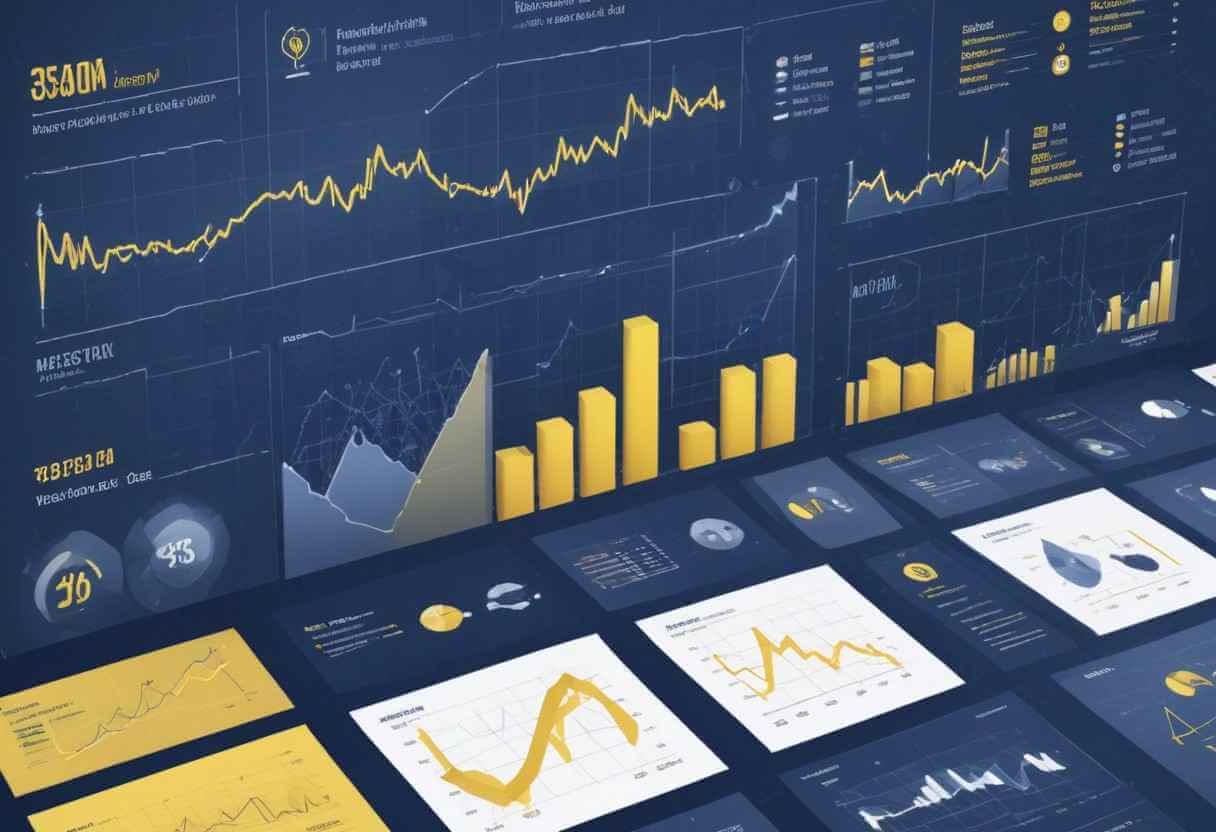For companies, big and small, Best AI Tools for Financial Forecasting stands as the cornerstone of strategic decision-making, especially for finance professionals in the FP&A team. In today’s digitally astute age, AI-equipped tools are revolutionizing how finance professionals interpret data and predict future financial trends, offering a futuristic alternative to traditional practices. From the C-Suite to aspiring founders, leveraging these tools provides unique insights into your financial state and helps improve forecast accuracy.
1. Xero
Xero enhances AI-driven analysis, allowing finance teams to gain a real-time view of financial data with features like automatic bank reconciliations and invoice tracking, exemplifying the benefits of financial forecasting software. This proactive approach allows enterprises to plan effectively with predictive insights, enhancing their financial forecasting capabilities.
2. Zoho Books
Zoho Books integrates AI to automate accounting tasks, provide cash flow forecasting, and manage expenses through predictive analytics. Ideal for medium to large businesses seeking top-notch financial modeling functionalities.
3. Oracle Financial Services
Available globally via Oracle partners, this AI-powered platform supports finance teams with complex financial needs, offering advanced risk management, regulatory compliance features, and tools for financial reporting.
4. SAP S/4HANA Finance
SAP S/4HANA Finance utilizes machine learning for financial planning and analysis, enabling faster decision-making with predictive analytics and scenario planning capabilities, showcasing the potential of AI financial forecasting.
5. Tableau
Tableau’s data visualization and AI-driven insights help financial analysts uncover hidden patterns and trends in data, facilitating better strategic decisions and improving overall financial performance.
6. Qlik
Qlik employs AI-driven technology to enhance data discovery and predictive modeling capabilities, optimizing financial processes and organizational profitability with generative AI applications.
7. IBM Planning Analytics
IBM Planning Analytics leverages machine learning to provide AI-powered continuous planning, forecasting, and scenario modeling for businesses, offering predictive intelligence for strategic decision-making.
8. Anaplan
Anaplan offers AI integration in its cloud-based platform, enabling Connected Planning across finance, sales, and operations, thereby accelerating decision-making processes.
9. Alteryx
Alteryx combines AI and machine learning in a single tool for advanced data preparation and predictive analytics, facilitating meaningful insights for financial analysts.
10. Sisense
Sisense is a leading AI-driven analytics platform offering agile solutions for financial forecasting, budgeting, and performance management, simplifying complex data for informed decision-making and enhancing financial performance.
The Role of Best AI Tools for Financial Forecasting
The integration of AI-powered tools in financial forecasting marks a significant advancement in how businesses interpret data and plan for the future. These technologies not only automate tedious tasks but also enhance the accuracy and depth of financial analysis, enabling finance professionals to make data-driven decisions with confidence. Here’s how AI is reshaping financial forecasting:
Enhanced Data Analysis and Predictive Insights
AI algorithms excel in processing vast amounts of financial data swiftly and accurately. By analyzing historical data and current trends, these AI models generate predictive insights that help businesses anticipate market changes, manage risks, and seize opportunities proactively through the use of AI financial forecasting.
Streamlined Financial Operations
Automation through AI streamlines financial operations such as accounting, budgeting, and cash flow management. This efficiency not only reduces manual errors but also frees up resources that can be redirected towards strategic initiatives and business growth.
Improved Decision-Making Capabilities
AI-driven analytics provide decision-makers with actionable insights in real-time, acting as an AI assistant to enhance their decision-making processes and improve forecast accuracy. By visualizing complex data in intuitive dashboards and reports, financial analysts can quickly identify key performance indicators (KPIs), assess financial health, and pivot strategies as needed, utilizing the best AI tools available.
Scalable and Flexible Solutions
Cloud-based AI platforms like Anaplan and Sisense offer scalable solutions that adapt to changing business needs, particularly in financial reporting and forecasting accuracy. Whether expanding operations or navigating economic uncertainties, these AI financial tools provide agility and flexibility crucial for sustained growth and resilience, particularly in traditional financial settings.
Future Outlook: Leveraging AI for Competitive Advantage
Looking ahead, the role of AI in financial forecasting will continue to evolve, driven by advancements in generative AI technologies. Innovations in machine learning and predictive analytics promise even greater accuracy and customization, enabling businesses to gain deeper insights into consumer behavior, market dynamics, and operational efficiencies.
Strategic Imperatives Post-COVID-19
In the aftermath of the global pandemic, businesses are recalibrating their growth strategies and operational resilience, increasingly using AI for financial modeling. AI technologies offer a strategic advantage by enabling organizations to forecast demand, optimize resource allocation, and mitigate financial risks effectively.
Democratizing Access to Advanced Analytics
The democratization of AI tools, such as Tableau and Alteryx, empowers finance teams across organizations to access and interpret complex data effectively, implementing AI for financial analysis. This accessibility fosters a culture of data-driven decision-making at all levels, enhancing organizational agility and innovation.
Optimizing Resource Allocation
AI tools such as IBM Planning Analytics and SAP S/4HANA Finance enable businesses to optimize resource allocation through advanced scenario modeling, predictive analytics, and the power of AI. By simulating various business outcomes based on different financial strategies, organizations can make informed decisions that maximize efficiency and profitability, incorporating AI financial forecasting techniques.
Enhancing Customer Insights and Engagement
Beyond operational efficiency, AI enhances customer insights by analyzing transactional data and behavioral patterns, providing a valuable use case for finance teams. This deep understanding allows businesses to personalize customer interactions, improve retention rates, and drive revenue growth through targeted marketing and service offerings.
Mitigating Financial Risks
In a volatile economic environment, AI-powered risk management tools, like those offered by Oracle Financial Services, play a crucial role in identifying and mitigating financial risks for finance professionals. By continuously monitoring market trends and regulatory changes, organizations can proactively adjust their strategies to safeguard against potential disruptions, leveraging AI for financial insights and forecasting tools.
Driving Innovation and Competitive Advantage
The integration of AI fosters a culture of innovation by accelerating the development of new financial products and services, particularly through the implementation of AI for financial solutions and AI financial modeling and forecasting. Companies leveraging AI-driven analytics, such as Tableau and Qlik, gain a competitive edge through faster decision-making and the ability to capitalize on emerging market opportunities using the best AI tools.
Ethical Considerations and Governance
As AI becomes increasingly integral to financial forecasting, addressing ethical considerations and ensuring responsible governance are paramount for finance professionals. Transparency in data usage, algorithmic bias mitigation, and adherence to regulatory guidelines are essential to maintaining trust and accountability in AI-driven decision-making processes, especially in financial reporting.
Future Trends and Opportunities
Looking forward, the evolution of AI in financial forecasting will likely lead to advancements in predictive capabilities, real-time data analytics, and cross-industry collaboration through innovative AI financial modeling and forecasting techniques. Emerging technologies, such as quantum computing and decentralized finance (DeFi), hold promise for revolutionizing financial forecasting methodologies and expanding the use case for AI applications, including AI financial modeling and forecasting.
Conclusion
Whether strategizing for new market penetration, optimizing cash flow, or expanding global market share post-COVID-19, leveraging AI and machine learning capabilities is crucial. These technologies empower finance teams to anticipate market changes and formulate proactive strategies, ensuring sustained growth and resilience in the future financial landscape through the best AI tools.
FAQ:
What is financial forecasting and why is it important?
Financial forecasting is the process of estimating future financial outcomes based on historical data, market trends, and various assumptions. It is crucial for businesses to make informed decisions regarding budgeting, resource allocation, and strategic planning. By understanding potential future financial performance, companies can better manage their cash flow, investments, and overall financial planning.
How does AI enhance financial forecasting?
AI enhances financial forecasting by utilizing advanced algorithms and machine learning techniques to analyze large datasets quickly and accurately. These AI tools can identify patterns and trends that may not be evident through traditional methods, improving forecast accuracy. Additionally, AI-powered tools can automate repetitive tasks, allowing finance professionals to focus on more strategic activities.
What are some essential AI tools for financial forecasting?
Some essential AI tools for financial forecasting include:
- AI financial forecasting software
- Generative AI for scenario planning
- AI financial modeling and forecasting tools
- Dashboards for financial reporting
- AI assistants for data analysis
These tools help finance teams streamline their processes and improve overall forecast accuracy.
What role does historical data play in financial forecasting?
Historical data is a fundamental component of financial forecasting. It provides the baseline for understanding past financial performance and helps in identifying trends and patterns that can inform future predictions.
Read More > Top 10 Personal Finance Apps to Manage Your Money Effectively
Read More > 10 Best Credit Card Providers with Rewards and Benefits
Read More > Financial Forecasting in the Age of AI: 10 Essential Tools
Read More > The Essential Guide to Small Business Insurance Requirements

